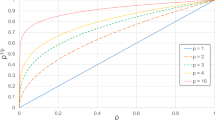Abstract
A new method for finite element model updating using simulated data is presented. A global-local optimization (GLO) approach was adopted to adjust the uncertain properties of the FE model by minimizing iteratively the differences between the measured dynamic modal parameters and the corresponding analytical predictions. In contrast with most of the existing updating techniques, which minimize modal force errors, objective functions based on Coordinate Modal Assurance Criterion (COMAC) and Frequency Response Assurance Criterion (FRAC) were employed. The GLO procedure was employed to minimize the norm of these vectors by updating the physical model variables (thickness, Young modulus, etc.). The proposed model updating procedure was applied to damage localization and quantification of structures, whose damage characteristics can be represented by a reduction of the element bending and axial stiffness. Results showed that a significant reduction in terms of computer run-time and improved damage assessment can be achieved. The procedure is illustrated on a plate-like structure by measuring dynamic properties before and after structural changes for four different damage cases.
Similar content being viewed by others
References
Alvin KF (1997) Finite element model update via Bayesian estimation and minimisation of dynamic residuals. AIAA J 35(5):879–886
Doebling SW, Farrar CR, Prime MB, Shevitz DW (1996) Damage identification and health monitoring of structural and mechanical systems from changes in their vibration characteristics: a literature review. Los Alamos National Laboratory, LA-13070, May 1996. http://www.lanl.gov/projects/ncsd/pubs/lit_review.pdf
Dossing O (1988) Structural testing. Part 1: mechanical mobility measurement. Bruel & Kjaer
Ewins DJ (2000) Modal testing: theory and practice. Research Studies Press LTD
Fotsch D, Ewins DJ (2000) Applications of MAC in the frequency domain. In Proceedings of the 18th international modal analysis conference, p 1225
Friswell MI, Mottershead JE (1995) Finite element model updating in structural dynamics. Kluwer Academic, Dordrecht
Jones K, Turcotte J (2002) Finite element model updating using antiresonant frequencies. J Sound Vib 252(4):717–727
Kammer D (1996) Optimal sensor placement for modal identification using system-realization methods. J Guid Control Dyn 19(3):729–731
Kaouk M (1993) Finite element model adjustment and damage detection using measured test data. PhD dissertation, Dept. of Aerospace Engineering Mechanics and Engineering Science, Univ. Florida, Gainesville, FL
Kohnke P (2001) ANSYS theory manual. ANSYS Inc
Lim TW (1995) Structural damage detection using constrained eigenstructure assignment. J Guid Control Dyn 18(3):411
Middlenton D (1960) An introduction to statistical communication theory. McGraw–Hill, New York
Modak SV, Kundra TK, Nakra BC (2002) Comparative study of model updating methods using simulated experimental data. Comput Struct 80:437–447
Monaco E, Fontana M, De Rosa L, Bellucci F, Lecce L (2002) Nondestructive technique based on vibration measurements and piezoelectric patches for monitoring corrosion phenomena. In: Smart structures and materials 2002: smart structures and integrated systems, pp 4701–4710
Rad SZ (1997) Methods for updating numerical models in structural dynamics. PhD dissertation, Imperial College. http://www.imperial.ac.uk/medynamics/publication/thesis/phd97ziaeirad.pdf
Teughels A, Maeck J, De Roeck G (2002) Damage assessment by FE model updating using damage functions. Comput Struct 80(25):1869–1879
Xia Y, Hao H (2000) Measurement selection for vibration-based structural damage identification. J Sound Vib 236(1):89–104
Zimmerman DC, Smith SW (1992) Model refinement and damage location for intelligent structures, from intelligent structural systems. In: Tzou HS, Anderson GL (eds) Intelligent structural systems. Kluwer Academic, Dordrecht, p 403
Author information
Authors and Affiliations
Corresponding author
Rights and permissions
About this article
Cite this article
Meo, M., Zumpano, G. Damage assessment on plate-like structures using a global-local optimization approach. Optim Eng 9, 161–177 (2008). https://doi.org/10.1007/s11081-007-9016-0
Published:
Issue Date:
DOI: https://doi.org/10.1007/s11081-007-9016-0




